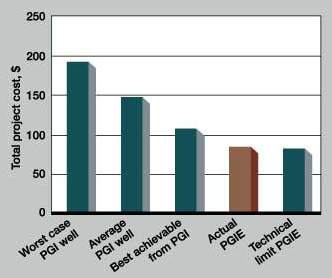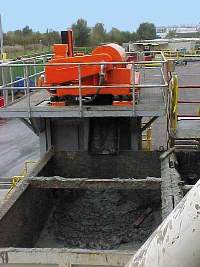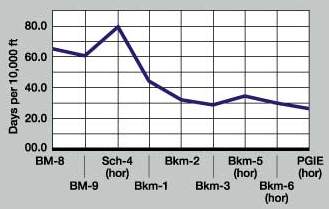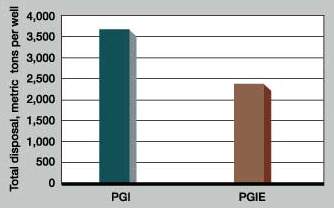Fluids management and batch drilling minimize waste and cut overall costs
DRILLING TECHNOLOGYFluids management and batch drilling minimize waste and cut overall costsAn incentive program and carefully planned drilling operations reduced project costs by more than 25%, while generating 54% less wasteMarc Wassenborg and Ronald van der Kraan, BP Amoco; and H. C. Osborn IV and Rob Nouris, M-I L.L.C.
Combining all fluids and waste management activities under the auspices of the drilling fluids contractor and the sequential drilling of each interval in a three-well program combined to reduce total project costs by more than 25%. Furthermore, when compared to the six wells completed in the first phase of the Peak Gas Installation (PGI) project, the subsequent Boekelermeer 7, 8 and 9 injection wells generated 54% less waste, thereby substantially reducing disposal costs and minimizing environmental impact. Field Background The Peak Gas Installation is a small, gas storage field in Alkmaar, an environmentally sensitive urban area some 25 mi northwest of Amsterdam. Brought on line in November 1997, PGI is used to maintain high pipeline pressure to meet increased winter demand, especially in peak early morning hours. To meet wintertime demands of national gas company Gasunie, the installation required a production capacity of 850 MMcfd. Owing to expectations of ever increasing demand, the operator exercised an option to expand capacity by 425 MMcfd to 1,275 MMcfd, thus launching the second-phase Peak Gas Installation Expansion (PGIE) program. Before the three-well expansion, the working volume of the reservoir was 8,825 MMcf. Traditional Drilling Practices Prior to the beginning of PGI’s first phase in 1995, the operator had drilled a number of wells in a mature area around Alkmaar in northwest Holland. Those wells historically were drilled with all services – including drilling fluids, solids control and waste management – tendered individually. When compared to earlier wells, a noticeable improvement in drilling efficiency was seen on the West Groet extended-reach well drilled in 1994 some 10 miles northwest of Alkmaar. While the well was drilled in half the days required for comparable offsets, the cost per foot jumped considerably to $513, compared to the average of $376 on previous wells. Further, associated mud, solids control and waste management expenses were $142/ft, some $33/ft higher than the average of the previous wells drilled in the area. Until then, the operator’s primary focus was maximizing rig and overall drilling efficiency. Wastes were viewed as something that needed proper disposal, but were seen as independent of the actual drilling operation. The results of West Groet illustrated the financial impacts resulting from inadequate environmental performance and the separation of environmental and drilling performance. In fact, data from a subsequent well revealed that mud and waste costs were as high as rig cost. Consequently, upon examining past environmental, drilling and financial performance, the operator embarked on a new approach as it began laying the groundwork for the PGI project. PGI Project The PGI utilizes the depleted Platten dolomite reservoir, first exploited with the Alkmaar 1 in 1965 to store gas for rapid take-off when demand on the grid peaks. Phase 1 commenced in 1995, ending roughly a year later with the drilling of the first six Boekelermeer injection wells. For this project, the operator initiated a pay-for-performance scheme that tied together most of the mud, solids control and waste management-related activities. However, not all aspects of the fluids cycle, such as oily waste, water-base mud cuttings and reservoir drilling fluids, were covered in the incentive payment scenario. These pieces of the cycle were omitted because the eventual volumes were unknown, thereby carrying too great a financial risk for the fluids provider. Once the six wells were completed, however, the excluded wastes could be benchmarked, thereby facilitating full ownership of the total fluids cycle on subsequent projects. For those principal areas covered (drilling fluids up to the reservoir and oil-base mud cuttings), the incentive targets established for each successive well were bested. All relevant data, including those volumes omitted from the pay-for-performance scheme, were captured, analyzed and benchmarked. On the basis of the benchmarked data, an idea board was constructed detailing all the lessons learned in the PGI development that could be transferred to the expansion project, which was to begin in November 1999. Noting opportunities for continuous improvement, especially in the waste management areas not covered in the initial incentive format, the operator put full ownership of every aspect of mud, solids control and waste management under the ownership of the fluids contractor. Complementing the integration of the fluids, solids control and waste management activities and a revised pay-for-performance scheme was the decision to batch drill the succeeding three wells. Integrating Fluid / Waste Management The concept of integrating all fluids and waste management activities under one umbrella has been well documented in the literature.1–5 The idea is rooted in the conviction that the associated products and services represent a natural grouping at the wellsite. Accordingly, it was perceived that the holistic management of these activities, and the better team-working and overall enhanced wellsite efficacy it would foster, could not only improve drilling efficiency and costs, but also health, safety and environmental performance. This natural grouping includes drilling, drill-in and completion fluids; solids control and filtration equipment; and waste treatment and remediation equipment and services. As Pruett, et al., explained, this grouping is natural to the extent that the performance of individual components is interdependent.2 Consequently, the joint management and execution of these processes with combined resources increases the opportunities for improved results. The process begins in the well planning stages and extends through completion, including the ultimate disposal of solid and liquid waste. The total fluids management approach goes well beyond shared infrastructure and personnel to exploit synergies in technology and delivery inherent in this natural grouping of products and services. Unlike approaches that simply bundle services, the holistic approach incorporates the total management of all fluids and waste activities and includes project planning procedures, best practices, benchmarking, specially designed software and other fluid-related technologies. Additionally, the completely linked product-and-service approach includes an integrated data management system that features a common database to analyze the interactions between all fluid system components. This component is fundamental for continuous analysis and measuring improvement. Since the success of an integrated approach to fluids and fluid management depends on proficient wellsite engineering capabilities, an extensive cross-training program was developed that includes the full gamut of drilling and completion fluids and waste management. The curriculum includes such topics as completion fluids, drilling technologies, drilling systems, drilling fluid economics, rig data acquisition, mud relationship to solids, solids control systems and waste minimization and treatment services. As such, an engineer assigned to a particular project has the training and expertise to oversee drilling fluids, completion fluids and all solids control / waste management activities. A truly integrated approach also requires that the on-site fluids engineer be empowered to manage all non-fluid associated wastes, be it everything from cementing activities to rainwater. PGIE Planning Exhaustive planning was seen as critical to the success of the PGIE program. The multi-faceted planning phase included a basic plan, coupled with contingencies that were designed to affect a smooth-running operation. A key component of the pre-drilling planning phase was the development of an all-inclusive project manual that disclosed in detail everything pertaining to mud, waste, solids control and was used as a guide book during project execution. Unlike previous wells drilled in the immediate area, the operator elected to use mainly personnel who had direct experience with PGI Phase 1. From the planning phase onward, the priority was choosing people with the right attitude, experience and skill sets to do the job safely and efficiently. For example, under the integrated services approach, the fluids / waste management provider assigned a project engineer who had supervised the previous PGI project. Likewise, the dedicated HSE coordinator had experience with the PGI, while the assigned solids control technicians had a working knowledge of the three different types of centrifuges and shakers to be used on the PGIE project. Correspondingly, drilling fluids engineers assigned to PGIE all had experience with not only the initial phase, but also with formations encountered in the immediate area, all Dutch drilling and environmental regulations and the four drilling fluid systems to be employed on the project. With a few minor exceptions, the design of the PGIE wells was almost identical to those in Phase 1, with both the casing-setting depths and drilling fluids remaining unchanged. During the planning stage, the following objectives were established for the PGIE project:
A number of avenues were identified as playing key roles in achieving those objectives. Besides employing the total management approach to the complete fluid cycle, the operator also identified batch drilling, an expanded pay-for-performance incentive scheme and a comprehensive audit of the solids control and waste management capabilities of the selected rig as being potentially vital contributors to the intended goals. In addition, to help meet the stringent HSE objectives, a "rewarding for reporting" incentive system was implemented that rewarded on-site personnel that exhibited good safety and environmental practices. Batch Drilling Scheme The driving force behind the decision to drill the three intervals of the wells sequentially was a perceived decrease in waste disposal, since less clean-up would be required. The most predominate impact was envisioned for the 12-1/4-in. sections, which were to be drilled with a low-toxicity, mineral-oil-base system. By batch drilling that section, the site would only have to be cleaned once before displacing with a water-base mud for the lower intervals. Under a conventional drilling scenario, the site would have to be cleaned three times before displacement. In the 12-1/4-in. section alone, the potential cost savings – with regards to solids control equipment, mud and disposal costs – were estimated to be an aggregate $228,000. Further savings also were envisaged by not having to make up and lay out the different bottomhole assemblies, since the rig will be capable of skidding to the next slot with the derrick full of drill pipe. An analysis of the predrilling time line indicated that the ability to simply rack the BHA in the derrick and proceed to the next slot could save at least two days of cumulative rig time on three wells. The two-day savings would equate to about $100,000. While there were some HSE issues pertaining to skidding the rig from one well to the next and then repeating the process, it was believed that not continually changing out BHAs would offset any potential risks. Since some third-party equipment and personnel could be released after the completion of each hole section, considerable savings also could be realized by minimizing stand-by personnel and services. Moreover, in keeping with the emphasis on continuous improvement, the lessons learned from the completion of each hole section could be transferred to the next, accelerating the overall learning curve on the project. Pay-For-Performance Incentive Another key facet of the planning process was the development of a new exponential incentive scheme inclusive for all affairs dealing with the fluids and waste management cycle. Using detailed information from the first stage of the PGI project, a cost-per-foot target was agreed upon, expressed as:
where;
The target agreed upon was not the average of the PGI project, but rather the "best achieved," Fig. 1. The best-achieved total-cost-per-foot target was calculated using the best of each item from each interval of all six of the initial PGI injectors. A technical limit target was calculated as the lowest cost achievable using current technology and pricing. In practical terms, the incentive means the closer the actual cost is to the technical limit, the closer the bonus gets to 50% of the savings.
The modified incentive program was employed primarily as a motivational tool to create full ownership of the entire fluid process. Accordingly, the payment of a bonus was tied to meeting the established targets, which, if exceeded, would result in break-even compensation. Thus, having a financial stake in the success or failure of a project spawns closer scrutiny of the total fluid cycle. This can be a driving force in reducing overall costs and ensuring project success. Consequently, the project can evolve into a major success story, rather than merely a success. Rig Audit Another key aspect of the comprehensive planning process was a thorough rig audit to be used for all the PGIE wells. A wide-ranging evaluation of the mud mixing, solids control and waste management systems on drilling rigs prior to spudding a well has been shown to have a dramatic impact on operational efficiency and ultimate fluid-related costs.6 Auditing the fluids handling capabilities of rigs early in the planning stages is a critical component in optimizing the design, delivery and management of fluids and wastes at the wellsite. During the audit, it was determined that the mixing and pit system of the rig needed upgrading. However, since the drilling location was close to the warehouse, it was decided that all fluids would be mixed off location and trucked to the rig site. Had the wellsite been farther away from the fluids mixing facility, upgrading or replacing the rig mixing equipment would have been imperative. On the rig, the solids control equipment was designed to not only meet the unique requirements of each interval, but be sufficiently flexible to handle the different fluid systems to be employed. For PGIE, a centrifuge and shaker selection process was initiated to choose "fit for purpose" solids control equipment. Among the additions deemed to hold the potential for reducing costs and running a more environmentally efficient solids control operation were sand screens and a specially designed "big bowl" centrifuge that promised to significantly reduce disposable waste and associated costs in the upper hole, Fig. 2.
Drilling, Waste Management Recap The PGIE wells were directionally drilled using steerable assemblies. Maximum hole inclination prior to building to horizontal in the reservoir sections was ±70°, with the final hole section built to horizontal and continuing for 1,968 ft to 2,624-plus ft through the reservoir. While drilling the reservoir, the wells were "geosteered" using LWD tools to maintain optimum wellbore placement and increase wellbore productivity in the high porosity layer of the Platten Dolomite. Hole TD was between 8,727 ft and 10,860 ft. The 16-in. upper hole sections were drilled with a water-base fluid system to protect shallow water sands from possible contamination from oil-base mud. The 12-1/4-in. intermediate holes were drilled with the low-toxicity, mineral-oil-base, drilling fluid system to control reactive formations, enhance wellbore stability at high inclination and prevent washouts in the salt sections. The final 8-1/2-in. sections were drilled with a calcium carbonate, water-base, drill-in fluid to minimize formation damage and minimize costs associated with lost circulation. The three wells were drilled in an average 26 days, exceeding the operator’s days-per-10,000-ft benchmark, Fig. 3. Furthermore, the final project cost was $19 million or $6.5 million under budget, which led to a bonus payment under the incentive pay-for-performance scheme.
Even the rig moves between slots went more smoothly and quickly than expected. During the planning phase, it was estimated it would take 1.5 days to skid the rigs from one well to the next; however, in actuality, the individual rig moves took around 18 hours and were closer to 12 hours during the latter stage of the project. The waste management performance was equally impressive, both from cost and total volume standpoints. When compared to PGI Phase 1, total disposal in metric tons per ft, excluding rainwater, was reduced from the 0.503 metric ton/ft average in PGI to the 0.222 metric ton/ft average in PGIE, Fig. 4. The volume reduction translated into a savings of $36.27/ft drilled.
The volume of liquid mud alone that had to be disposed of was reduced 85%. Much of the reduction in the volume of liquid wastes generated was attributed to the use of the big bowl centrifuge that enabled mud used in the 16-in. sections – which would otherwise have been diluted and dumped – to be reused on other wells. Overall, the costs of drilling fluids, solids control and waste handling on the three PGIE wells averaged $85.34/ft compared to the $148.13/ft average of the six original PGI wells. At the end of the project, all of the identified goals had been met or
exceeded. Not only did the project come in well under budget, more importantly, it was completed with no
significant environmental or safety incidents. In addition, the targeted 425 MMcf increase in capacity was
shown to be 495 MMcf after testing.
Literature Cited
|
||||||||||||||||||||||||||||||||||||||||||||










